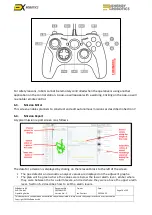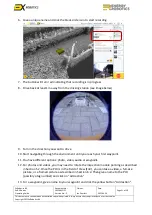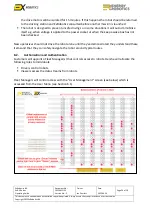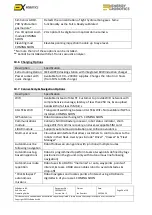
ExRobotics B.V.
ExR-2 Robot
Operating Guide
Document No.:
20220412IP1
Version No.: 2
Owner:
Ian Peerless
Date:
2022-04-30
Page 23 of 39
This document is considered an uncontrolled copy when printed. Always ensure that you print and use a current version.
Copyright 2022 ExRobotics B.V.
For the robot to repeat the taught mission:
1.
Change to the “Driver Screen”
2.
Select the mission from the “Robot Control” list
3.
Click
the “Play” icon.
7.5.
Skills
Skills are processes that provide information when doing inspections. For example, the manometer
detector and value extraction process is a Skill already included. In the future, we will extend the
list of Skills available to customers as well as provide a platform to include customer or third-party
developed Skills. These will be updated when they are commercially available.
7.6.
Click and Inspect
This section will be updated when click and inspect autonomy is commercially available.
8.
Operating Robots
8.1.
Operative Training
Experienced operatives will explain the safety items in the Robot Operating Instructions and Guide
to new operatives and key site pe
rsonnel. They’ll also show new operatives how to use the control
station.
In particular they should emphasise the importance of careful driving:
▪
Impact damage to facilities, people and the robot can be avoided by careful driving.
▪
Always check the surroundings using all cameras before enabling the drive motors.
▪
When starting a mission and reversing away from the docking station, the driver should use
the inspection module panning to look behind the robot and check for obstructions.
▪
Test the controls after leaving the docking station and before commencing a mission.
▪
Approach hazards such as ledges, sumps, ramps, overhead obstructions and the docking
station with the speed set in
“slow”
mode. Allow for communications latency.
▪
Don’t
spot turn on grass/mud/anti-slip gratings/gravel because this might cause a track to
jam. (spot turns are when you drive the robot left or right with no forwards or backwards
motion).
▪
The robot isn’t designed to climb stairs or gradients above
35 degrees. It may topple over. It
can however cross steps up to 10cm high. Approach them perpendicularly.
▪
The downward facing drive camera can enable precise positioning.
▪
The warranty does
n’
t cover impact damage.
▪
The robot must be returned to the docking station at the end of a mission and before the
battery is fully discharged. If the battery charge reaches 0% the sensors may work but the
robot w
on’t
drive which will require a visit to the site and robot recovery to the docking
station. This will also invalidate the battery warranty.
▪
To prevent over-heating, robots monitor the temperature of the battery pack. If
it’s
too high a
warning will be displayed on the control station. The driver should stop the robot and wait 15
minutes for the batteries to cool before recommencing the mission. If the driver does not act,






























